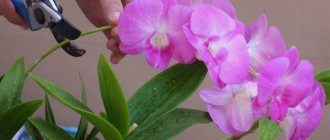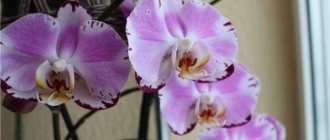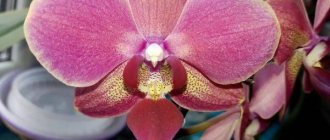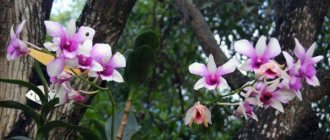Description of Phalaenopsis
Padova
This variety of orchid is native to Southeast Asia. It has a pleasant pink color with a golden center . As a rule, it produces 1-2 peduncles with 7-10 flowers on it.
It blooms mainly in autumn-winter ; in summer it does not show much activity. It reaches a height of 65 cm, the size of flowers is about 9 cm.
Hybrid Phalaenopsis Padova.
This hybrid variety is not very whimsical , its maintenance conditions are as follows:
- Air temperature 18-20 degrees;
- Humidity more than 60%;
- Moderate lighting.
Important! Phalaenopsis Padova is very responsive to sudden changes in temperature: if the room is less than 16 degrees, the plant can shed unopened buds and leaves.
It reproduces, like all other phalaenopsis, by throwing out and then replanting babies. This is best done in spring or early autumn.
During the period of vegetative growth, it is recommended to feed a little with special fertilizers for orchids. If you take good care of the Padova variety, the plant can live for about 7 years and delight its owner with constant flowering.
Palermo
This type of phalaenopsis is very popular among all orchids. It differs from all its relatives in its unusual appearance: delicate flowers with a beautiful pale pink color.
Palermo is distinguished by its unusual appearance: delicate flowers with a beautiful color of pale pink.
Description of Palermo:
- The petals have small streaks of cream color;
- The plant grows up to 60 cm in height, the size of flowers can be up to 8 cm;
- The Palermo variety is a hybrid orchid and is very easy to care for;
- The temperature should be within 15-18 degrees, the air humidity should be quite high;
- Additional humidity can be created by spraying, but this must be done carefully so as not to wet the blooming flowers and leaves, as this can cause the development of a fungal infection.
Advice! It is necessary to fertilize several times a week in the summer; in winter and autumn, the amount of fertilizer can be reduced to 1 time every 7-14 days.
Plants need to be watered as the soil dries out. The plant is very lush and blooms profusely due to its small flowers.
The dormant period between flowering is 1-2 months. If properly cared for, the plant can produce 2-3 flower stalks. See what a blooming Palermo orchid looks like in the photo below.
Photo of a blooming Palermo orchid.
Of particular interest are the hybrid varieties Palermo trilips and peloric.
Phalaenopsis Trilips is unique for its beautiful flowers with petals that are shaped like triangles.
Peloric is a designation for a form of phalaenopsis flowers that is atypical for this species, which was formed due to a genetic failure or mutation. Many lovers adore pelorics for their uniqueness and beauty. The colors of these varieties of orchids range from light lilac to deep violet with cream stains.
And here is a video with the Palermo variety:
Pandora
This hybrid Phalaenopsis variety is distinguished by its appearance:
- On long peduncles there are white flowers with a burgundy center ;
- The length of the peduncle can reach 50-55 cm in height;
- The diameter of the flowers is small - up to 7 cm;
- During flowering, up to 7-9 flowers can form on one stem;
- The Phalaenopsis Pandora orchid blooms almost all year round , with short dormant periods of 1 month.
Pandora is very popular in the Philippines.
This phalaenopsis variety is very popular in the Philippines .
Care will not require excesses from the hostess:
- The temperature is the same as for other varieties of orchids,
- Humidity should be high
- to water the plant when the soil dries out.
- Allowed to spray . Feeding should be moderate in the summer and plentiful during the period of vegetative growth,
- to replant after the plant has finished blooming.
- Reproduces from “babies”, which can be formed with proper care,
- The Palermo variety does not like bright sunlight ; it is best to place the pot with the plant on the windowsill in the early morning or in the evening.
In addition to white flowers, this variety boasts an unusual coloring: the delicate white flowers have bright lilac specks, while the center remains burgundy.
Peabody
This is a bright orchid that will warm you with its color in the cold season. It is distinguished by its bright fiery color.
Phalaenopsis Peabody is distinguished by its bright fiery color.
Phalaenopsis Peabody was bred in a hybrid way, has up to 2 peduncles , the size of the flowers is 7-9 cm. Up to 10 flowers can be placed on one peduncle. The plant can grow 55-75 cm in height. In the middle of the bright yellow flower there is a soft pink center.
The lifespan of this variety is 5-7 years with proper care. It is not necessary to maintain high temperatures, but it is necessary to observe conditions of high air humidity. This can be done with regular spraying.
Planting soil required by Phalaenopsis Peabody is a universal substrate for orchids.
It is recommended to water this variety in the following way: lower the pot into a container of water so that it covers it halfway. Keep in this form until the substrate is completely saturated.
It blooms mainly in winter and spring, the duration of dormancy is from 1 to 2 months (as a rule, this is the hot summer season).
Distinctive characteristics
Phalaenopsis pink is considered one of the smallest subspecies of domestic orchids. In the wild, it prefers to settle on the banks of rivers. The plant has characteristic features that distinguish it from other subspecies:
- The rosette of a plant usually consists of 2–5 oblong leaf plates. Each leaf reaches 15–20 cm in length and 4–6 cm in width.
- The peduncles are short (up to 30 cm), but abundantly covered with pink buds, the number of which can reach 16–20 pieces. Small flowers open one after another, creating the feeling of a long bloom.
- The color of the flowers varies from pale pink to purple and even crimson (depending on the variety). Often flowers combine several shades at once.
- Phalaenopsis inflorescences can be arched and branched or simple. The flowers reach 2–3 cm in diameter.
- Externally, phalaenopsis is distinguished by elongated pink sepals with vertical white stripes. The lip is small, has three lobes, and can be colored in several shades at once (from white-pink to dark crimson and orange-yellow).
Main features of proper landing
Priming
For planting these hybrid varieties, standard orchid soil .
It must include:
- A little peat
- oak bark,
- Drainage system (such as coconut chips or pieces of foam).
The right containers
It is recommended to plant the plant in special plastic containers of various diameters; they have holes at the bottom for water access.
Such a container can be placed in a bright orchid pot, which is ideal for your interior. It can be plastic, ceramic or glass.
Technology
You need to plant the plant as follows: pour a little drainage into the bottom of the orchid container, then a small amount of substrate. Place the plant there and cover it with the rest of the soil.
The nuances of transplantation
This should be done after the plant has stopped blooming .
Reproduction is carried out from children that are thrown out by the orchid in the same way.
Do not tamp or press on the plant, as this can damage the root system.
Watering after transplantation is allowed no earlier than a week later.
You can feed 30 days after transplantation.
Are there species with blue, cyan and black pigmentation in nature?
More recently, this question would have been answered: blue/blue, black, and here’s why:
- Black orchids. There are no absolutely black orchids; they are all essentially a very dark and rich tone of burgundy, green or purple. The dark marsh-colored orchids look especially believable as black, and they also have a pleasant vanilla scent.
- Blue/blue orchids. They don't exist in nature. Until 2011, it was not in the hands of breeders. They were first presented at an exhibition in Philadelphia, but it was officially stated there that the blue miracle flower is the result of a patented coloring. Subsequent blooms of such a plant became increasingly paler with a dirty tint and eventually turned white.
In 2013, Japan presented its blue orchid to the world, and it will no longer disappoint with its fading, since it was obtained by introducing Commelina genes into Phalaenopsis Aphrodite.
Important! The number of such colors is limited. Blue orchids can only be purchased by special order.
Home care rules
Conditions of detention
The optimal conditions for growth and flowering are :
- Temperature within 16-20 degrees;
- Air humidity not less than 60%;
- Moderate lighting.
Watering and fertilizing
water as the soil dries out:
- In the summer, 1-2 times a week,
- In winter, once every 2 weeks.
You can use fertilizer during the period of vegetative growth. It is recommended to take special mineral fertilizers for orchids.
Disease Prevention
If the basic rules of watering are not followed, the orchid can be affected by fungal diseases. To prevent them, you can use special fungicidal agents .
To prevent ticks, special acaricidal agents are used; they must be used to treat the plant 3-4 times a day if ticks are suspected. You also need to adhere to the correct temperature and humidity so that the plant does not get sick.











